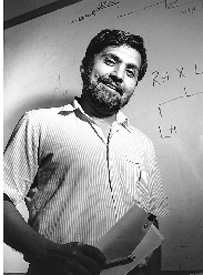| Dr. Klar received his Ph.D. in bacteriology at the University of Wisconsin in 1975 under Dr. Harlyn O. Halverson. He then studied genetics as a postdoctoral fellow at the University of California with Dr. Seymour Fogel. In 1978, Dr. Klar joined the staff at Cold Spring Harbor Laboratory, where he served as director of the Delbruck laboratory from 1985 to 1988. In 1988, he joined the ABL-Basic Research Program as head of the Developmental Genetics Section. In 1999, Dr. Klar joined the Center for Cancer Research, NCI-Frederick. |
The Developmental Genetics Section is mainly interested in the genetics and molecular biology of gene silencing and mating-type switching in Schizosaccharomyces pombe. In this yeast, the mating-type region consists of three loci called mat1, mat2, and mat3. The mat2 and mat3 loci are always silent and only act as donors of genetic information required for switching the transcriptionally active mat1 locus. We found that the silencing mechanism involves a chromosomally heritable epigenetic alteration, presumably of chromatin associated with the mat region. We showed that the epigenetic event is maintained and inherited through meiosis as a conventional Mendelian marker. We have identified cis-acting sequences and trans-acting genes whose products participate in silencing. Molecular analysis of two such genes, designated clr3 and clr6 (for cryptic loci regulator), showed that they encode homologs of histone deacetylase. We showed that another gene, clr4, encodes a chromodomain protein, a motif thought to be essential for silencing; furthermore, we showed that this gene is essential to the directionality of switching. This work strongly supports our model that gene silencing in the mating-type region is mediated by organization of the repressive chromatin structure. Future work will address the molecular biology of clr gene products as well as the mechanism of inheritance and duplication of the epigenetic mark during DNA replication.
Another aspect of our research has explained the mechanism of asymmetric cell division such that only one among four related granddaughter cells undergoes a mating-type switch. We showed that this pattern results from another site- and DNA strand-specific alkali-labile modification at mat1 that efficiently initiates the recombination required for mat1 interconversion. We have shown that the orientation of DNA replication with respect to leading- and lagging-strand synthesis establishes the mating-type switching pattern. We have proposed that such an asymmetric stem-cell like division in the meristem of plants may form the basis of placement of successive organs at a fixed angle according to the mathematic series first described over 800 years ago by Leonardo Fibonacci. This model is to be contrasted with the commonly accepted but unestablished model of morphogen-gredients.
In another project, we have evidence that a single locus, RGHT, specifies preference for hand utilization in humans and that individuals with the recessive allele have a 50:50 chance of being either right-handed (RH) or left-handed (LH). We proposed a model for a single gene (RGHT = Right- and r = random-handedness) controlling human hand preference and obtained data satisfying two key genetic predictions of the model. First, by calculating the gene frequency from RH x LH families, the model explains the percentage of LH children observed in RH x RH families. Second, the RH children of LH x LH families carry the r/r genotype, because they produce a higher percentage of LH children as predicted, similar to that of LH individuals in the general population. This model also explains discordance of handedness in monozygotic twins due to randomicity in hand preference of r/r individuals. We speculate that the RGHT locus functions primarily to specify cerebral laterality such that language is processed in the left-brain hemisphere and secondarily to coordinate left-brain dominance with development of the right-hand preference. We recently discovered that a common genetic mechanism controls handedness and perital hair-whorl orientation. Most people are righties and their hair whorls coil clockwise. Interestingly, the lefties and the ambidextrous individuals are equally divided in developing clockwise and anticlockwise whorl rotations. Thus, nature controls the handedness trait. Encouraged by these results, we plan to map the gene, with the ultimate goal of cloning it for molecular analysis. For this purpose, we are searching for families in which one or both parents are RH with two LH children (over 16 years old) and all additional children, if any, should be RH. Curiously, schizophrenic and bipolar disorder patients are three times more often LH compared to those in the general population. We speculate that genetics controlling handedness predisposes individuals for the psychosis. However, this partial association of psychosis with handedness needs to be experimentally verified.
Recently, we have pointed out that a large Scottish family with chromosome I and II translocation provides the best evidence favoring genetics as the sole cause of psychosis. Interestingly, only one-half of translocation heterozygate individuals are diseased. The results with the translocation provide support to our model positing DNA strand-specific imprinting and non-random DNA chain segregation for the development of human psychosis. We propose that the translocation causes random chromatid distribution at a specific cell division during embryogenesis, thus resultling in the disease in one-half of heterozygous individuals. |






